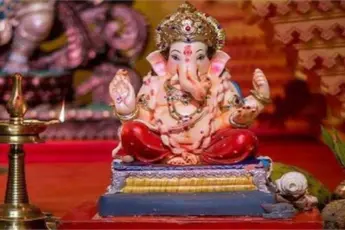Our Puja
Home
Ganesh Chaturthi
Ganesh Chaturthi, also known as Vinayaka Chaturthi, is a Hindu festival celebrating the birth of Lord Ganesha. It is observed with great devotion and enthusiasm in India and by Hindus around the world.
The festival involves the installation of Ganesha clay idols privately in homes, or publicly on elaborate pandals (temporary stages). The puja (worship) involves several steps and rituals, which are performed to invoke Lord Ganesha’s blessings. Here is a simplified step-by-step guide to performing Ganesh Chaturthi Puja:

Preparation
- Clean the house: Before the arrival of Lord Ganesha, clean your house thoroughly.
- Set up the altar: Choose a clean, auspicious place in your home to install the idol. Decorate the area with flowers, garlands, and rangoli.
- Ganesh Idol: Procure an eco-friendly Ganesh idol.
- Puja Items: Prepare a list of puja items and gather them. Common items include turmeric, vermilion, sandalwood paste, incense sticks, camphor, coconut, fruits, sweets (especially Modak, as it is believed to be Lord Ganesha’s favorite), betel leaves, betel nuts, and durva grass.
2. Avahana (Invocation)
- Pran Pratishtha: It is the ritual to invoke Lord Ganesha’s presence into the idol. Chant the appropriate mantras to invoke Ganesha.
3. Asana Samarpana
- Offer a seat to Lord Ganesha, symbolically using a small cloth or Akshata (rice grains mixed with turmeric).
4. Padya Samarpana
- Offer water to Lord Ganesha’s feet to wash them, symbolizing respect and humility.
5. Arghya Samarpana
- Offer water to Lord Ganesha’s hands for cleansing.
6. Achamana
- Offer water for sipping, which is a symbolic purification of the mouth and lips.
7. Snanam (Bath)
- Offer a symbolic bath with water, followed by Panchamrita (a mixture of milk, curd, honey, ghee, and sugar). Afterward, cleanse with pure water. Then, dry the idol and apply sandalwood paste or turmeric.
8. Vastra (Clothing)
- Offer a new cloth or thread as a symbol of respect and honor.
9. Yajnopavita
- Offer the sacred thread to Lord Ganesha.
10. Gandha (Sandalwood)
- Apply sandalwood paste or turmeric on the idol as a symbol of purity.
11. Pushpa (Flowers)
- Offer fresh flowers or garlands to Lord Ganesha. Durva grass and red flowers are particularly auspicious.
12. Dhoop (Incense)
- Light incense sticks to purify the atmosphere.
13. Deep (Lamp)
- Light a lamp (preferably with ghee) to symbolize bringing light into the home and heart.
14. Naivedya (Food Offering)
- Offer sweets, fruits, and prepared food to Lord Ganesha. Modak or laddus are traditionally offered as they are considered Ganesha’s favorite.
15. Aarti
- Perform the Ganesha Aarti with a camphor or ghee lamp, while singing or playing devotional songs dedicated to Lord Ganesha.
16. Pradakshina and Pranam
- Circumambulate the idol or the altar, symbolizing respect and homage to Lord Ganesha. Then, bow down to offer your respects and prayers.
17. Mantrapushpanjali
- Offer flowers while chanting mantras to honor and pray to Lord Ganesha for his blessings.
18. Visarjan (Immersion)
- On the last day of the festival, the Ganesha idol is taken in a procession and immersed in a water body. This ritual symbolizes sending Lord Ganesha back to his celestial home while taking away the devotees’ misfortunes.


Remember, the intention and devotion with which the puja is performed are more important than the exactness of the ritual. Adapting the steps according to personal circumstances and abilities is acceptable.
